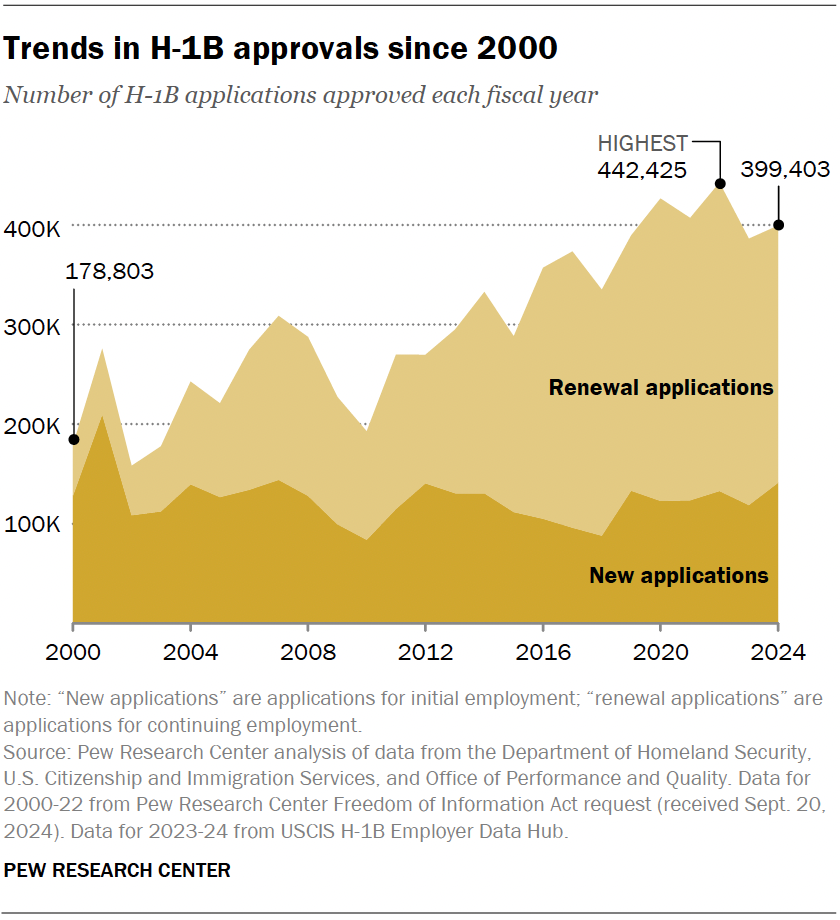The $100,000 H1-B visa shock

In today’s Finshots, we try to understand the new H1-B debate that Trump’s sparked. That’s it!
But here’s a quick sidenote before we begin. We’re gathering real reviews for Health & Term Insurance policies to feature on the Ditto Insurance website, and we’d love your help!
It’ll only take a minute or two:
• Click here for Health Insurance
• Or here for Term Insurance
P.S. Your review might just make it to our policy pages.
Thanks for helping us out!
Now, onto today’s story.
The Story
Donald Trump did it again. Just as the world was stepping into the weekend, the US President signed a proclamation that slaps a $100,000 fee on new H1-B visas (from around $1,000). And chaos rolled in. Because H-1Bs keep US tech running, and nearly 70% go to Indians.
Sensing the panic, the White House quickly clarified that the levy is a one-time fee, not annual; it hits only fresh petitions, not renewals; and there’s a vague “national interest” clause tucked into the fine print.
But if anything, the clarification has raised more questions than it answered. Even for us, as we were going through these changes. So, in an attempt to understand the fundamental issue better, I imagined a debate with Mr. Trump himself…
Me: So, let’s talk about this H-1B business, Mr. Trump. You argue it’s being abused. You’re not entirely wrong. There are consulting shops that game the system by filing multiple applications, benching workers, or undercutting wages. But let’s, for the sake of this debate, say that every single H-1B issued this year was “abused.” That’s still only 85,000 jobs (the cap for H1-B visas) or 0.03% in a population of 330 million Americans.
Trump: Or it’s 85,000 American jobs given away! But it’s not just numbers. It’s a principle. You’re inviting foreigners when Americans need work. During recessions, during layoffs, shouldn’t citizens come first?
M: Right. But H-1Bs don’t exist in a vacuum. Last year, 780,884 people applied for those 85,000 spots. So less than 11% got through. Companies clearly see demand. And look at who fills them: highly skilled software engineers, doctors, biotech researchers. These aren’t roles with a huge surplus of local candidates.
T: We could train locals instead of leaning on foreigners.
M: That’s a nice sentiment. But America itself was built on immigrants. Families that arrived with nothing were leading companies in two or three generations. That’s why 46% of Fortune 500 companies today were founded by immigrants or their kids. Firms like Apple, Google, and Tesla — together they generate trillions in revenue and employ millions of Americans. That’s not cultural erosion but growth.
T: But wages? Don’t H-1Bs depress local salaries?
M: No, Mr. Trump. You can read this piece that we put out. It proves that immigrants on H-1B visas might actually be benefitting Americans more than people think.
T: ….
M: And immigrants also start companies, hire locals, and pay taxes. And if the US doesn’t keep them, they build giants elsewhere. Look at TSMC in Taiwan. Its founder trained in America, but built the world’s most critical chipmaker back home. And today, the US debates going to war over Taiwan because of TSMC’s strategic importance. Imagine if it had been built in Silicon Valley.
T: Fine, but the system is unfair. Indians flood the pool, and they clog up green cards. I’ve not been liking that of late.
M: That’s an important nuance. But H-1Bs have no country quota. Everyone competes equally. The backlog comes later, at the green card stage.
T: My voters don’t care about nuance. They see layoffs, then see foreigners with jobs. They conflate H-1Bs with illegal immigration. They want the border shut.
M: Exactly. But the two are worlds apart. Illegal immigration can strain welfare and law enforcement. Legal immigration like H-1Bs brings in skilled taxpayers. That distinction gets lost in the noise.
T: I’ve said it before, I actually like H-1Bs. I’ve used them at my properties. It’s a great program when done right. I just want it tightened, not scrapped.
M: So why the $100,000 fee?
T: Because I can. Tremendous number. Makes headlines.
M: …
Yeah, that may not be the healthiest conversation, but it makes a few things clear. Each side clings to its truth. Abuse exists, but so does genuine demand. Americans deserve protection, but immigrants add enormous value and they pay taxes. And instead of holding all those truths together, the debate gets flattened. And that’s what makes it so messy.
Now, we’re no experts at this. And what we say today might look different a few years down the line, in a different political or economic environment.
But what we can do right now is come back to the $100,000 question. And try to separate the noise from what really matters.
The fine print of Trump’s order is telling.
For starters, Homeland Security (DHS) has been asked to refuse petitions unless the fee is paid upfront for any new H-1B petition filed after September 21, 2025. So admission itself now hinges on proof of payment. And most crucially, agencies must rewrite how H-1Bs are prioritised and how “prevailing wages” are calculated. In fact, the Department of Labor has been directed to raise prevailing wage levels, while DHS has been told to prioritise higher-paid roles in the lottery.
In other words, even if the $100,000 toll vanishes next year, the structural changes may not. Today, the lottery treats all petitions equally. But under wage-ranking, a $200,000 AI engineer has a far better shot than a $70,000 coder. And that could squeeze out thousands of IT outsourcing-linked roles, which have averaged about 65% over the past 5 years.
The report counters this by saying that several tech giants have laid off thousands of American workers while simultaneously securing large batches of H-1B approvals. But the reality is more layered. Because many of those layoffs could be tied to global slowdowns, automation, and shifts to cloud or AI — work that is increasingly outsourced regardless of visa policy. You can see this in the H1-B approvals itself, where ‘new applications’ have plateaued over recent years, while a big chunk of filings are simply renewals or extensions. In those cases, employers foot the bill, but the trade off is that workers often find it harder to switch jobs and can end up earning less compared to American-counterparts doing the same job.

And then there’s the ambiguity of “national interest”. The US issued around 470,000 H-1B approvals over the past five years. If the government now starts reserving a chunk of those for sectors it deems strategic (say AI, semiconductors, or defense tech) it means fewer visas for everyone else. And a vague definition could also tilt the game toward companies with lobbying power rather than genuine skill shortages.
Funnily enough, this is where Trump’s stance today looks very different from his fiery promises of yesterday. He once threatened to shut the program down; now he seems more interested in reshaping it. So it’s neither extreme idealism nor protectionism. It comes out as a balanced attempt to look tough while quietly keeping the door open for global talent and let the US get what it wants.
Because, as we saw, anti-immigration is, in many ways, anti-America itself. And to shut the door on scalable talent is to deny its own history.
As Thomas Friedman explains in the book The World is Flat, talent is the new oil and nations that harness it will thrive. Those that block it will eventually pay the price. “…in a flat world there is no such thing as an American job. There is just a job, and in more cases than ever before it will go to the best, smartest, most productive, or cheapest worker—wherever he or she resides.”
Which brings us to the last bit — who pays the price here?
Well, there will surely be some winners and losers in the short run.
For Indian IT giants, the calculus may shift: why pay $100,000 per entry-level engineer onsite when you can expand delivery centres in India? And fresh Indian grads with US job offers could be the first casualties. The winners could be US universities, because scarcity of visas may drive more students to pay for a degree in hopes of improving their odds later. And offshore global capability centres (GCCs) in India may benefit too. Over 1,800 multinationals already run GCCs here, many tied to US firms. So if US companies balk at the $100k fee, that number could climb rapidly.
In the meantime, you need to keep an eye on three dials: One, how the entry levels by the US immigration gets defined; two, how wage-ranking reshapes the lottery; and three, whether courts ultimately uphold Washington’s authority to price-gate a visa program at scale.
In the long scheme of things, though, top talent will make the cut. Marginal onsite roles in the US could quietly vanish. And that, ironically, could be a silver lining for India. If the pipeline of fresh grads heading west slows, more of it gets retained at home before it’s lured away by offers somewhere else. That means deeper domestic markets, more Indian IT companies deploying capital onshore rather than relying on wage arbitrage, and a slowdown in the aspirational US shift.
For big Indian IT houses, the blow won’t be crippling since they have already been investing heavily in US local hiring. And this simply accelerates that strategy, and makes India’s pitch to capture more of global R&D and product engineering from home.
There’s also a legal and political undercurrent worth noting. Industry groups and law firms are already lining up challenges, and litigation may come. If courts issue an injunction, the shock may be blunted. If not, the fee becomes a standing constraint.
But here’s the problem: lawsuits take time. Businesses don’t. They’ll budget for the worst-case and adjust hiring today. And that timeline friction — when rules are uncertain but hiring decisions can’t wait — often does more damage to the economy than the rule itself.
So that’s the real catch for the US. Push jobs offshore and it doesn’t just protect local workers but it risks losing tax dollars, startups, and the very breakthroughs that keep it ahead in the global race.
So tell us, which side are you on? And where are your bets?
Until then…
Sharing is caring. If you found this story useful, please do consider telling your friends about it. All you have to do is send it on WhatsApp, LinkedIn, or X and ask them to subscribe! :)
